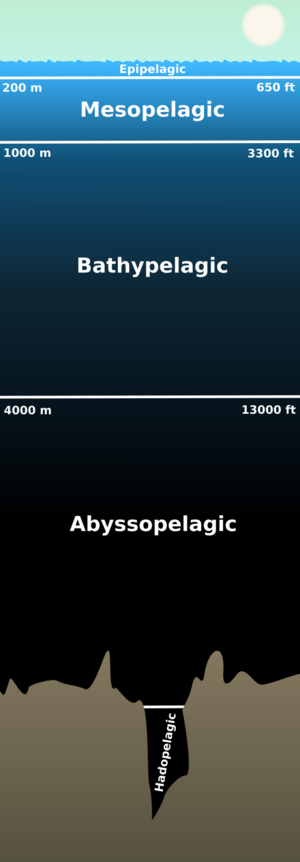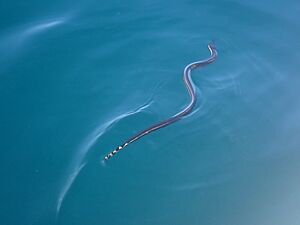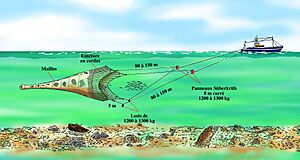Pelagic zone facts for kids
The pelagic zone is the vast, open part of the ocean, far away from the shore and the bottom. The word "pelagic" comes from an ancient Greek word meaning "open sea." You can think of it as a giant column of water stretching from the ocean's surface all the way down to the seabed.
As you go deeper into this water column, conditions change a lot. The pressure increases, and it gets colder and darker. Other things like saltiness, oxygen, and tiny nutrients also change. Just like the Earth's atmosphere has different layers, the ocean's water column can be divided into several layers based on depth.
Marine life in the pelagic zone swims freely. It's not held back by the seafloor, coastlines, or underwater mountains. This zone is all about the wide-open waters where creatures can move in any direction.
The pelagic zone is different from coastal waters, which are near the shore and usually quite shallow. It's also different from the benthic zone, which is the very bottom of the sea, including the sand and mud. Creatures living on the bottom, like clams and crabs, are called benthos. Just above the benthic zone is the demersal zone, where fish like bottom feeders live either resting on the bottom or swimming just above it. The pelagic zone is truly the realm of the open water.
The pelagic zone is incredibly vast, covering about 1.33 billion cubic kilometers of water. Its average depth is about 3.68 kilometers, but it can go down to an amazing 11 kilometers in some places! As you go deeper, you'll find fewer and fewer living things.
Contents
The Amazing Pelagic Zone
The pelagic zone is a huge part of our planet, full of mystery and life. It's where many amazing ocean creatures live, from tiny plankton to giant whales. Understanding this zone helps us learn more about the ocean and how to protect it.
Exploring Ocean Depths: Layers of the Pelagic Zone
The pelagic zone is divided into five main vertical layers. Each layer has its own unique conditions and types of life. Let's explore them from the surface down to the deepest parts.
The Sunlight Zone: Epipelagic
This is the top layer, from the surface down to about 200 meters (650 feet). It's called the sunlight zone because it gets plenty of sunlight. This light is super important for tiny plants called phytoplankton to make their own food through photosynthesis. Almost all the ocean's food production happens here, and about 90% of marine life lives in this zone. You'll find plankton, floating seaweed like Sargassum, jellyfish, tuna, whales, sharks, and dolphins here. The pressure here is the lowest in the ocean, about 1 atmosphere for every 10 meters of depth.
The Twilight Zone: Mesopelagic
Below the sunlight zone, from 200 meters down to about 1,000 meters (3,300 feet), is the twilight zone. Here, the water gets much colder, and only a tiny bit of sunlight can reach. The pressure increases, ranging from 20 to 100 atmospheres. Many creatures in this zone have special adaptations, like bioluminescence (making their own light), because it's so dark. You might find swordfish, squid, wolffish, and some cuttlefish here. Some animals even swim up to the sunlight zone at night to feed. Tiny bacteria are also very common, breaking down falling food from above.
The Midnight Zone: Bathypelagic
This zone stretches from 1,000 meters down to about 4,000 meters (13,000 feet). It's completely dark here, like permanent midnight, with no sunlight at all. The only light comes from bioluminescent creatures, like the anglerfish with its glowing lure. The temperature and saltiness are very stable in this zone. No plants can grow here. Most animals survive by eating "marine snow" – tiny bits of dead plants and animals falling from the upper zones – or by hunting other creatures in the dark, like the marine hatchetfish.
The Abyssal Zone: Abyssopelagic
Even deeper, from 4,000 meters down to just above the ocean floor, is the abyssal zone. The name "abyssal" means "bottomless." Here, the ocean floor creates amazing landscapes with volcanoes, mountains, and vents formed by moving tectonic plates. It's incredibly cold, with immense pressure, and total darkness. Only a few special creatures can live here, such as different types of squid, echinoderms like the basket star and sea pig, and marine arthropods like the sea spider. Many animals in this zone are transparent and don't have eyes because there's no light to see with.
The Hadal Zone: Deepest Trenches
The hadal zone is the deepest part of the ocean, going beyond 6,000 meters (20,000 feet). It's named after Hades, the Greek god of the underworld. These extreme depths are usually found in long, narrow trenches. Some trenches are over 10,924 meters deep! The pressure here can be over 1,100 times what it is at the surface. Despite these harsh conditions, a few unique creatures have been found, including some types of jellyfish-like animals, worms, amphipods, starfish relatives, and mollusks.
Life in the Open Ocean: The Pelagic Ecosystem
The pelagic ecosystem is a complex web of life. It all starts with tiny phytoplankton in the sunlight zone. These microscopic plants are the base of the food chain, making their own food using sunlight. As you go deeper, where there's less oxygen, more pressure, colder temperatures, and less food, the variety of life decreases a lot.
Tiny Creatures: Pelagic Invertebrates
Many small animals without backbones live in the open ocean. These include krill, tiny copepods, jellyfish, young squid and octopus, and other small crustaceans. These tiny creatures are a vital food source for many larger animals.
Fish of the Open Waters: Pelagic Fish
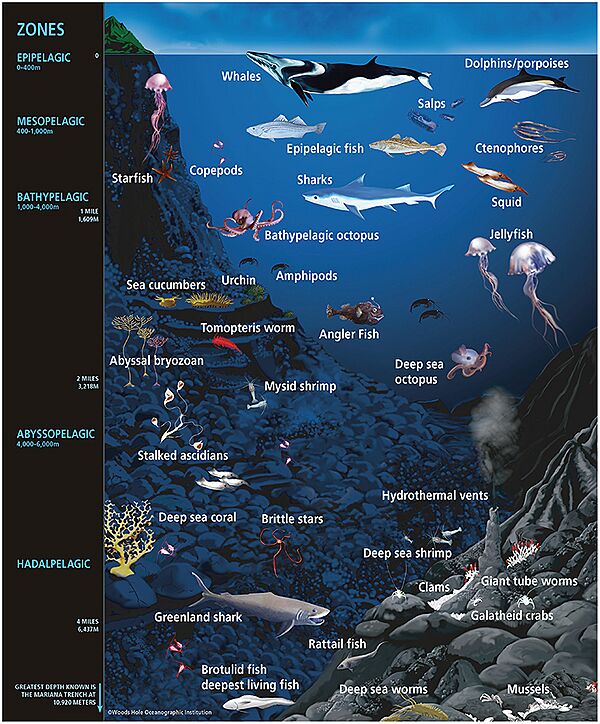
Pelagic fish are those that live in the open water, not on or near the bottom. They are different from fish that live on the seabed or in coral reefs. Many pelagic fish are migratory, meaning they travel long distances.
Some, like herring, anchovies, and capelin, are "forage fish." They eat plankton and are a food source for larger predators. These forage fish often swim up to shallower, food-rich areas to feed, then go deeper at night to avoid predators. Bigger pelagic fish, like billfish, tuna, and oceanic sharks, hunt and eat these smaller forage fish.
Ocean Reptiles: Sea Snakes and Turtles
The yellow-bellied sea snake is special because it spends its entire life in the open ocean. It even has its babies at sea and cannot survive on land. These snakes are found in many parts of the world's oceans.
Many species of sea turtles also spend their early years swimming in the pelagic zone. As they grow older, they often move closer to the shore.
Birds of the Open Sea: Pelagic Birds
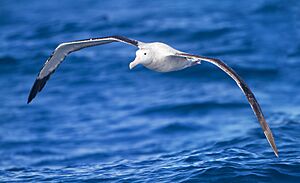
Pelagic birds, also known as oceanic birds or seabirds, live far out at sea, away from land, rivers, or lakes. These birds have very long wings, which help them fly for incredibly long periods. Some can even dive deep into the water to catch their food. Pelagic birds eat small crustaceans, squid, and small fish. Famous examples include the Atlantic puffin, macaroni penguins, sooty terns, shearwaters, and the magnificent albatross.
Who Eats Whom? The Pelagic Food Web
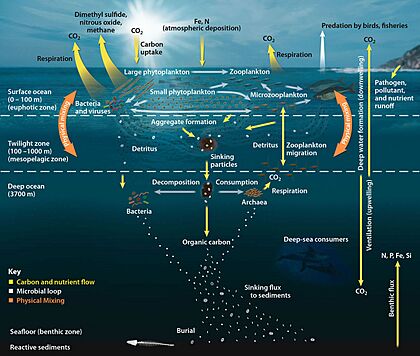
The ocean's food web is a bit different from what you might see on land. In the ocean, the total weight of the tiny plant-like organisms (phytoplankton) is actually smaller than the total weight of the animals that eat them (like copepods, krill, and small fish). This is because phytoplankton grow and reproduce incredibly fast, so a small amount can feed a much larger group of animals.
Tiny animals called zooplankton are super important in this food web. They are the main link between the phytoplankton (the primary producers) and all the other animals in the ocean.
When phytoplankton die before being eaten, they slowly sink through the water column. This falling material is called "marine snow." As it sinks, it carries carbon dioxide from the surface down to the deep ocean. This process helps the ocean store about 2 billion tons of carbon dioxide each year, making the ocean a huge "carbon sink."
Scientists also discovered something cool in 2010 called the "whale pump." Whales feed on krill in deeper parts of the ocean, but they come to the surface to breathe. When they do, they release a liquid waste rich in nitrogen and iron. This liquid stays near the surface, where phytoplankton use it to grow. In some areas, like the Gulf of Maine, the whale pump provides more nutrients for phytoplankton than rivers do!
Discovering the Deep: How Scientists Study the Pelagic Zone
Learning about the ocean is crucial for managing its resources and understanding our planet's climate. Scientists use many methods to study the pelagic zone and its amazing creatures.
Catching Fish with Trawling Nets
One way to study deep-sea fish is by using large mesh nets called trawls. These nets are dragged behind a boat at different depths to catch organisms. This method can collect many specimens, but it can be expensive and time-consuming. Also, many fast-swimming fish can escape the nets, so the data might not show everything.
Listening to the Ocean: Active Acoustics
This method uses sound waves to detect fish. Scientists send out sound pulses from the surface and analyze the echoes that bounce back. This helps them estimate how many fish are in an area. This method covers a wide area and causes little harm to the ocean. However, interpreting the data can be tricky because different fish have different body structures, like swim bladders, that affect how sound reflects.
Underwater Robots: Remotely Operated Vehicles (ROVs)
Remotely Operated Vehicles, or ROVs, are unoccupied machines that scientists use to explore the deep pelagic sea. These robots are equipped with lights, cameras, sensors, and even robotic arms. This allows scientists to make detailed, live observations of the deep ocean and its creatures, conduct experiments, and collect samples. ROVs are amazing, but they are expensive and can be hard to control. They also cover a limited area, and their lights and noise can sometimes scare away animals.
Other Ways to Learn About the Ocean
Scientists also use other cool methods to study the pelagic zone. They examine the stomachs of predators to see what they ate, analyze environmental DNA found in the water, and study organisms that wash up on shore. They also look at sediment cores from the ocean floor and use special longline fishing techniques.
See also
 In Spanish: Piélago para niños
In Spanish: Piélago para niños


